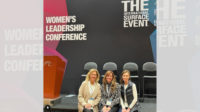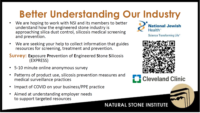
When I opened up my paper of choice, The New York Times, two weeks ago, I saw a headline in the Home Section entitled, “What’s Lurking in Your Countertop?” By now, we all probably know much of what happened as a result of this article. Subsequently, other major news outlets - including radio and network television - have picked up the story. On YouTube, videos appeared showing people holding a Geiger counter against a granite slab - dramatic scenes with jumping needles and lots of noise indicating that something is seriously awry. Stone distributors and fabricators started receiving way too many calls from concerned homeowners - some hysterical; some reasonable but worried.
This is not the first time we’ve heard about possible dangerous connections between radon and granite, and it’s been refuted quite effectively by scientific research in the past. This time, it seemed different from the beginning. The story seemed to arrive with a purpose, and it quickly acquired legs. It didn’t take a lot of work to uncover a connection between two major manufacturers of engineered stone (Silestone and Cambria) and an organization called BuildClean, whose singular mission seems to be to raise concerns about granite and radon - without a shred of supporting scientific data.
Clearly, these two companies stand much to gain from creating a perception that granite countertops are unsafe, since they happen to be marketing their products as “safe and cleaner countertops.” (These words are taken directly from Silestone’s new marketing campaign, curiously announced to the media just days after The New York Times article ran).
Ulterior motives set aside, we now need to know more facts. In addition to what I feel was irresponsible journalism on the part of the Times, misinformation seems to be spreading through the public. One example of this was astutely pointed out by Radon.com, an online authority on radon and testing for radon, which has a section on its home page stating that “Geiger Counters are being used for dramatic effect and are misleading in two principle ways.” First, “simple hand-held Geiger Counters are not calibrated for measuring ONLY the radon-producing Radium in granite,” which usually results in false high readings. Second, “up to 80% of the Geiger Counter clicks may come from potassium,” which is found in many foods and in our body. Since radon is actually found in granite and other rock deposits, we need to understand the potential danger. Any radon emitted from granite is most likely negligible and completely harmless in any normal environment, meaning that once it enters a home, any radon gas is diluted in the air to the point that it is harmless. So if you have radon in your home, the least likely culprit is your granite countertop. It’s more likely a crack in your basement’s foundation, allowing radon to escape into your home. Proper ventilation solves this problem in most cases.
As an industry, how do we respond? The Marble Institute of America (MIA) has done exactly what a trade association should do in this situation. They immediately started an aggressive campaign to discredit these reports and they mobilized industry leaders to band together to fight this attack on our industry. The Truth About Granite Fund that they set up has received excellent response, with one large U.S. importer contributing $100,000 and several distributors and overseas manufacturers pledging $50,000 each. Please consider contributing to this cause; every bit helps.
“The MIA is compiling a list of the top 100 granites sold in the U.S. and we will be conducting independent tests to determine if any granites currently sold are actually dangerous,” said Gary Distelhorst, Executive Director of the MIA. Their president, Jim Hogan, wrote an excellent letter to the editor of The New York Times that points out its lack of scientific rigor, which I have yet to see published. (We have published a copy of this letter in the September 2008 edition of our Stone World Fabricator E-News, which can be found at www.stoneworld.com.)
I applaud the MIA for its efforts. In the end, the most important thing we need is an independent test, approved by the government and/or the scientific community, to alleviate any and all consumer concerns.
As an industry, our reaction also must be responsible. We cannot simply say “granite is safe” and make blanket statements about our products. I’ve heard reports that a few select granites from Brazil and Africa may have higher radiation levels, but even these may pose no danger; we just don’t have the hard facts yet. As an industry, it is our responsibility to find any “hot” materials and get them off the market. The last thing we need is the appearance of a cover-up or lack of concern for public safety.
As an industry, our reaction also must be responsible. We cannot simply say “granite is safe” and make blanket statements about our products. I’ve heard reports that a few select granites from Brazil and Africa may have higher radiation levels, but even these may pose no danger; we just don’t have the hard facts yet. As an industry, it is our responsibility to find any “hot” materials and get them off the market. The last thing we need is the appearance of a cover-up or lack of concern for public safety.
Other efforts have been undertaken, including a meeting in Brazil among leading granite producers which resulted in a signed letter from the president of Cosentino USA, which distributes Silestone here (as well as a line of granites, ironically), stating that “radon-wise, most granite and Silestone have similar readings, meaning that they are all harmless to human beings.” At press time, I learned about a meeting between Cosentino and members of the Stone Fabricators Alliance (SFA) in an attempt to stop the damaging marketing campaign that may help us move forward, but in my mind, much of the damage has already been done. Customers are quietly switching from granite to alternate materials, and some contractors and builders will avoid granite because they simply don’t want the hassle and potential for trouble down the line. No one likes a call-back, and even fewer people welcome a lawsuit. We need to return confidence to the consumer.
Now more than ever, the industry needs to come together as a unified front and mount a major public relations campaign to show that granite truly is safe and is still a great building material. As a board member of the Natural Stone Council (NSC), I feel like the time is right to unify our industry. As part of this, the NSC’s proposed revenue-based donation program (Check-Off Program) for raising funds for this industry might just be exactly what we need. As a group, we have the power to educate, inform and hopefully become stronger together. There’s something lurking out there, and it smells, but it’s not radon.


